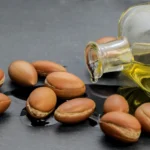Africa’s beauty secrets are as diverse as its landscapes, and two oils—argan oil (Argania spinosa) from Morocco and moringa oil (Moringa oleifera) from across sub-Saharan Africa stand out as treasures with centuries of tradition behind them. Once staples of local kitchens and rituals, they are now prized in the global beauty world for their nourishing, restorative qualities.
Understanding their heritage, nutrients, and uses helps us appreciate not just what they do for our skin, but also the cultures and ecosystems they come from.
Argan Oil: Morocco’s Liquid Gold
Known as “liquid gold,” argan oil has been produced for centuries in Morocco, where the argan tree grows almost exclusively. Traditionally, Berber women hand-cracked the kernels to extract oil a practice that continues today, often through women’s cooperatives that sustain rural communities.
Nutrient Profile & Benefits
- Argan oil is particularly rich in oleic and linoleic acids, essential fatty acids that support skin barrier repair, along with high levels of vitamin E, a powerful antioxidant. These components help keep skin supple, reduce transepidermal water loss, and protect against environmental stressors.
- Lightweight and fast-absorbing, argan oil is suitable for most skin types, including oily and acne-prone, where it may help balance sebum. It is also used on hair to tame frizz and restore shine. While often praised for protecting skin against sun damage, it is important to clarify that argan oil does not replace SPF; instead, it supports the skin’s resilience. While it supports barrier health, argan oil is not a replacement for sunscreen.
Cultural and Culinary Uses
Be Beyond beauty, argan oil has deep culinary roots. In Morocco, it is blended with almonds and honey into amlou, a nutritious dip served with bread. This dual role nourishing inside and out illustrates its place in daily life.
Moringa Oil: The Miracle Tree’s Gift
The fast-growing moringa tree has long been valued across Africa and Asia for its edible leaves, medicinal uses, and oil. Known as “ben oil,” moringa seed oil was even used in ancient Egypt for skin care and lamp fuel.
Nutrient Profile & Benefits
- Moringa oil’s defining component is behenic acid, a rare fatty acid that gives the oil stability and long-lasting emollience. It also contains vitamins A and E and a spectrum of antioxidants that make it highly valued for anti-aging formulations.
- Absorbing quickly without greasiness, moringa oil hydrates deeply, improves elasticity, and calms dryness or mild irritation. Its oxidative stability means it has a longer shelf life than many botanical oils, making it excellent for both skincare and haircare. Like argan, moringa oil does not provide SPF but can help condition and protect skin.
Traditional and Culinary Uses
In many African communities, moringa leaves are eaten in soups or stews, valued for their protein and micronutrient content. The seeds, when pressed, yield an oil traditionally used to soothe skin and condition hair bridging wellness, food, and beauty. moringa seeds are used for water purification, while the fruit pulp and leaves are consumed as nutrient-dense food.
Practical Guidance: How to Use Argan & Moringa Oils
- Cold-pressed, unrefined oils retain the most nutrients and aroma; refined oils are milder and more shelf-stable.
- Shelf life: 12–18 months when stored in dark glass bottles, cool and airtight.
- Facial use: Start with 2–3 drops on damp skin.
- Blends: Use at 3–10% in DIY serums or creams.
- Patch test: Always test on inner forearm for 24–48 hours before wider use.
- Allergy caution: Argan is a tree-kernel oil — those with nut allergies should consult a professional before use.
DIY Recipe: Nourishing Hair & Skin Elixir
Ingredients
- 2 tbsp argan oil (cold-pressed)
- 2 tbsp moringa oil (cold-pressed)
- 1–2 drops vitamin E oil (optional, to extend shelf life)
- 5 drops rosemary essential oil (optional, for scalp health — keep ≤0.5% if using on face)
Instructions
- Combine oils in a sterilized glass dropper bottle.
- For hair: Massage a few drops into scalp and ends once or twice a week.
- For skin: Apply 2–3 drops to clean, damp face or body.
Safety notes: Always patch test first (24–48 hrs.). Store in a cool, dark place. Use within 6–
12 months for best freshness.
Sustainability & Ethical Sourcing
- Argan oil: Primarily wild-harvested in Morocco, often through women’s cooperatives that provide fair income and help protect argan forests (a UNESCO Biosphere Reserve).
- Moringa oil: Frequently cultivated by smallholder farmers in Africa and Asia, supporting local economies and soil regeneration.
When buying, look for:
Fair Trade or organic certification
Transparent brands that disclose sourcing Commitment to sustainable harvesting practices By choosing responsibly, you support both the environment and the communities who have safeguarded these traditions for centuries.
Final Thoughts
Argan and moringa oils represent two very different landscapes but share a common story: heritage, resilience, and community empowerment. From Morocco’s cooperatives to Africa’s moringa farms, these oils are more than skincare trends they are part of living traditions that sustain both people and ecosystems.
Whether added to your hair ritual, blended into a facial serum, or massaged into dry skin, these oils embody the best of African beauty wisdom meeting modern skincare science.
Related Posts
-
African beauty oils: Ancestral wisdom meets modern skincare
Across Africa’s diverse landscapes from the sunbaked Kalahari to the lush savannas of West Africa…
-
Launching a Strategy for Norway’s Engagement with African Countries
What will be important for Norway in its Africa policy in the coming years?Foreign Minister…
-
South African Chakalaka (Spicy Vegetable Relish)
Chakalaka is South Africa’s vibrant answer to a flavor-packed vegetable relish. Traditionally served alongside pap…


